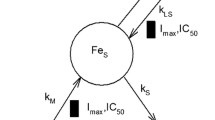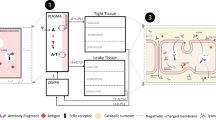Abstract
Hepcidin is a key regulator responsible for systemic iron homeostasis. A semi-mechanistic PK model for hepcidin and a fully human anti-hepcidin monoclonal antibody (Ab 12B9m) was developed to describe their total (free + bound) serum concentration-time data after single and multiple weekly intravenous or subcutaneous doses of Ab 12B9m. The model was based on target mediated drug disposition and the IgG–FcRn interaction concepts published previously. Both total Ab 12B9m and total hepcidin exhibited nonlinear kinetics due to saturable Fc–FcRn interaction. Ab 12B9m showed a limited volume of distribution and negligible linear elimination from serum. The nonlinear elimination of Ab 12B9m was attributed to the endosomal degradation of Ab 12B9m that was not bound to the FcRn receptor. The terminal half-life, assumed to be the same for free and total serum Ab 12B9m, was estimated to be 16.5 days. The subcutaneous absorption of Ab 12B9m was described with a first-order absorption rate constant k a of 0.0278 h−1, with 86% bioavailability. The model suggested a rapid hepcidin clearance of approximately 800 mL h−1 kg−1. Only the highest-tested Ab 12B9m dose of 300 mg kg−1 week−1 was able to maintain free hepcidin level below the baseline during the dosing intervals. Free Ab 12B9m and free hepcidin concentrations were simulated, and their PK profiles were nonlinear as affected by their binding to each other. Additionally, the total amount of FcRn receptor involved in Ab 12B9m recycling at a given time was calculated empirically, and the temporal changes in the free FcRn levels upon Ab 12B9m administration were inferred.








Similar content being viewed by others
References
Donovan A, Roy CN, Andrews NC. The ins and outs of iron homeostasis. Physiology (Bethesda). 2006;21:115–23.
Hentze MW, Muckenthaler MU, Andrews NC. Balancing acts: molecular control of mammalian iron metabolism. Cell. 2004;117(3):285–97.
Abboud S, Haile DJ. A novel mammalian iron-regulated protein involved in intracellular iron metabolism. J Biol Chem. 2000;275(26):19906–12.
McKie AT, Marciani P, Rolfs A, Brennan K, Wehr K, Barrow D, et al. A novel duodenal iron-regulated transporter, IREG1, implicated in the basolateral transfer of iron to the circulation. Mol Cell. 2000;5(2):299–309.
Ganz T. Molecular control of iron transport. J Am Soc Nephrol. 2007;18(2):394–400.
Nicolas G, Bennoun M, Devaux I, Beaumont C, Grandchamp B, Kahn A, et al. Lack of hepcidin gene expression and severe tissue iron overload in upstream stimulatory factor 2 (USF2) knockout mice. Proc Natl Acad Sci USA. 2001;98(15):8780–5.
Krause A, Neitz S, Magert HJ, Schulz A, Forssmann WG, Schulz-Knappe P, et al. LEAP-1, a novel highly disulfide-bonded human peptide, exhibits antimicrobial activity. FEBS Lett. 2000;480(2–3):147–50.
Rivera S, Nemeth E, Gabayan V, Lopez MA, Farshidi D, Ganz T. Synthetic hepcidin causes rapid dose-dependent hypoferremia and is concentrated in ferroportin-containing organs. Blood. 2005;106(6):2196–9.
Lin L, Valore EV, Nemeth E, Goodnough JB, Gabayan V, Ganz T. Iron transferrin regulates hepcidin synthesis in primary hepatocyte culture through hemojuvelin and BMP2/4. Blood. 2007;110(6):2182–9.
Nemeth E. Iron regulation and erythropoiesis. Curr Opin Hematol. 2008;15(3):169–75.
Detivaud L, Nemeth E, Boudjema K, Turlin B, Troadec MB, Leroyer P, et al. Hepcidin levels in humans are correlated with hepatic iron stores, hemoglobin levels, and hepatic function. Blood. 2005;106(2):746–8.
Kemna E, Pickkers P, Nemeth E, van der Hoeven H, Swinkels D. Time-course analysis of hepcidin, serum iron, and plasma cytokine levels in humans injected with LPS. Blood. 2005;106(5):1864–6.
Nemeth E, Rivera S, Gabayan V, Keller C, Taudorf S, Pedersen BK, et al. IL-6 mediates hypoferremia of inflammation by inducing the synthesis of the iron regulatory hormone hepcidin. J Clin Invest. 2004;113(9):1271–6.
Levy G. Pharmacologic target-mediated drug disposition. Clin Pharmacol Ther. 1994;56(3):248–52.
Jin F, Krzyzanski W. Pharmacokinetic model of target-mediated disposition of thrombopoietin. AAPS PharmSci. 2004;6(1):E9.
Mager DE, Jusko WJ. General pharmacokinetic model for drugs exhibiting target-mediated drug disposition. J Pharmacokinet Pharmacodyn. 2001;28(6):507–32.
Mager DE, Neuteboom B, Efthymiopoulos C, Munafo A, Jusko WJ. Receptor-mediated pharmacokinetics and pharmacodynamics of interferon-beta1a in monkeys. J Pharmacol Exp Ther. 2003;306(1):262–70.
Ng CM, Stefanich E, Anand BS, Fielder PJ, Vaickus L. Pharmacokinetics/pharmacodynamics of nondepleting anti-CD4 monoclonal antibody (TRX1) in healthy human volunteers. Pharm Res. 2006;23(1):95–103.
Roskos LK, Lum P, Lockbaum P, Schwab G, Yang BB. Pharmacokinetic/pharmacodynamic modeling of pegfilgrastim in healthy subjects. J Clin Pharmacol. 2006;46(7):747–57.
Samtani MN, Perez-Ruixo JJ, Brown KH, Cerneus D, Molloy CJ. Pharmacokinetic and pharmacodynamic modeling of pegylated thrombopoietin mimetic peptide (PEG-TPOm) after single intravenous dose administration in healthy subjects. J Clin Pharmacol. 2009;49(3):336–50.
Segrave AM, Mager DE, Charman SA, Edwards GA, Porter CJ. Pharmacokinetics of recombinant human leukemia inhibitory factor in sheep. J Pharmacol Exp Ther. 2004;309(3):1085–92.
Sugiyama Y, Hanano M. Receptor-mediated transport of peptide hormones and its importance in the overall hormone disposition in the body. Pharm Res. 1989;6(3):192–202.
Woo S, Krzyzanski W, Jusko WJ. Target-mediated pharmacokinetic and pharmacodynamic model of recombinant human erythropoietin (rHuEPO). J Pharmacokinet Pharmacodyn. 2007;34(6):849–68.
Eppler SM, Combs DL, Henry TD, Lopez JJ, Ellis SG, Yi JH, et al. A target-mediated model to describe the pharmacokinetics and hemodynamic effects of recombinant human vascular endothelial growth factor in humans. Clin Pharmacol Ther. 2002;72(1):20–32.
Gibiansky L, Gibiansky E, Kakkar T, Ma P. Approximations of the target-mediated drug disposition model and identifiability of model parameters. J Pharmacokinet Pharmacodyn. 2008;35(5):573–91.
Hayashi N, Tsukamoto Y, Sallas WM, Lowe PJ. A mechanism-based binding model for the population pharmacokinetics and pharmacodynamics of omalizumab. Br J Clin Pharmacol. 2007;63(5):548–61.
Marathe A, Peterson MC, Mager DE. Integrated cellular bone homeostasis model for denosumab pharmacodynamics in multiple myeloma patients. J Pharmacol Exp Ther. 2008;326(2):555–62.
Lobo ED, Hansen RJ, Balthasar JP. Antibody pharmacokinetics and pharmacodynamics. J Pharm Sci. 2004;93(11):2645–68.
Waldmann TA, Strober W. Metabolism of immunoglobulins. Prog Allergy. 1969;13:1–110.
Ferl GZ, Wu AM, DiStefano 3rd JJ. A predictive model of therapeutic monoclonal antibody dynamics and regulation by the neonatal Fc receptor (FcRn). Ann Biomed Eng. 2005;33(11):1640–52.
Garg A, Balthasar JP. Physiologically-based pharmacokinetic (PBPK) model to predict IgG tissue kinetics in wild-type and FcRn-knockout mice. J Pharmacokinet Pharmacodyn. 2007;34(5):687–709.
Hansen RJ, Balthasar JP. Pharmacokinetic/pharmacodynamic modeling of the effects of intravenous immunoglobulin on the disposition of antiplatelet antibodies in a rat model of immune thrombocytopenia. J Pharm Sci. 2003;92(6):1206–15.
Harrison RE, Grinstein S. Phagocytosis and the microtubule cytoskeleton. Biochem Cell Biol. 2002;80(5):509–15.
Israel EJ, Wilsker DF, Hayes KC, Schoenfeld D, Simister NE. Increased clearance of IgG in mice that lack beta 2-microglobulin: possible protective role of FcRn. Immunology. 1996;89(4):573–8.
Li H, Rose MJ, Tran L, Zhang J, Miranda LP, James CA, et al. Development of a method for the sensitive and quantitative determination of hepcidin in human serum using LC-MS/MS. J Pharmacol Toxicol Methods. 2009;59(3):171–80.
D'Argenio DZ, Schumitzky A. ADAPT II user's guide: Pharmacokinetic/Pharmacodynamic System Analysis Software. Los Angeles: Biomedical Simulations Resource; 1997.
Davies B, Morris T. Physiological parameters in laboratory animals and humans. Pharm Res. 1993;10(7):1093–5.
Gibiansky L, Gibiansky E. Target-mediated drug disposition model: relationships with indirect response models and application to population PK-PD analysis. J Pharmacokinet Pharmacodyn. 2009;36(4):341–51.
Lowe P, Gautier A. On the ability to predict free ligand suppression when free ligand assays are not available or impossible. Population Approach Group in Europe Abstract. 2009;1595:18.
Lu X, Miller CJ. Concentration of IgG in the sera of normal rhesus macaques as determined by a species-specific radial immunodifusion assay. J Immunol Methods. 1996;177:193–6.
Edison ES, Bajel A, Chandy M. Iron homeostasis: new players, newer insights. Eur J Haematol. 2008;81(6):411–24.
Tomosugi N, Kawabata H, Wakatabe R, Higuchi M, Yamaya H, Umehara H, et al. Detection of serum hepcidin in renal failure and inflammation by using ProteinChip System. Blood. 2006;108(4):1381–7.
Mager DE, Krzyzanski W. Quasi-equilibrium pharmacokinetic model for drugs exhibiting target-mediated drug disposition. Pharm Res. 2005;22(10):1589–96.
Acknowledgments
This study has been sponsored by AMGEN, which was involved in the study design, data collection, analysis, interpretation, writing of the manuscript, and the decision to submit the manuscript for publication. JX, YMW, HL, MR, MM, YW, BH, and JJPR were employees of AMGEN and own stock in AMGEN when the analysis was conducted. WK received consulting fees from AMGEN. They have no other conflict of interest to declare.
The authors thank Drs. George Doellgast and Hossein Salimi-Moosavi for their support on ELISA development and optimization. The authors also thank Dr. Barbra Sasu and Dr. Andrew Chow for their scientific support.
Author information
Authors and Affiliations
Corresponding author
APPENDIX
APPENDIX
Derivation of Eqs. 9–16
The full (non-reduced) TMDD PK model as presented in Fig. 1 encompasses differential equations describing AbE, FcAbE, AbHE, and FcAbHE variables:
Let E denote the amount of free and H25 bound Ab 12B9m in the endosomal compartment:
Similarly, let FcE denote the amount of the complexes FcRn–Ab 12B9m and FcRn–Ab 12B9m–H25 in the endosomal compartment:
Adding Eqs. 23 and 25, and Eqs. 24 and 26 results in the following differential equations for E and FcE:
Consequently, the combined species E bind to the FcRn receptor as if it is a single drug. The equilibrium assumptions Eq. 1a, b can be written as
Adding Eq. 31a, b and dividing by FcE results in
which means that the equilibrium assumption applies also to the combined species E. Repeating the argument for the quasi-equilibrium TMDD model (43), one can conclude that
and
where
Notice that Eq. 33 is identical to Eq. 14, since Eq. 34 is the sum of Eqs. 9 and 10. In order to derive Eqs. 15 and 16, one needs to re-write Eq. 2 to the following form
and substitute it to Eq. 31a, b. These will constitute a system of two linear equations with unknowns FcAbE and FcAbHE that can be easily solved resulting in Eqs. 15 and 16. Finally, Eqs. 11a, b and 15 imply
Multiplication of Eq. 37 by the denominator yields
and Eq. 15 follows. Equation 16 can be derived in a similar way.
Equations 32 and 33 imply that
Rights and permissions
About this article
Cite this article
Xiao, J.J., Krzyzanski, W., Wang, YM. et al. Pharmacokinetics of Anti-hepcidin Monoclonal Antibody Ab 12B9m and Hepcidin in Cynomolgus Monkeys. AAPS J 12, 646–657 (2010). https://doi.org/10.1208/s12248-010-9222-0
Received:
Accepted:
Published:
Issue Date:
DOI: https://doi.org/10.1208/s12248-010-9222-0




